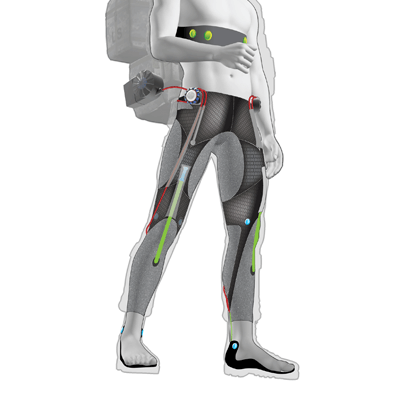Researchers at the School of Mechanical Engineering at Chung-Ang University in South Korea have developed a lightweight exosuit that enhances a human’s natural ability to sprint, paving the way for a more robust medical rehabilitation process and helping people with mobility issues and concerns.
How Does the Exosuit Work?
Designed to be a seamless extension of the human body, this exosuit aids in sprinting, a fundamental human ability. Exosuits are made of soft, flexible fabrics, and unlike their cousin technology, the exoskeleton, they have minimal supporting structures. Exoskeletons are more rigid, usually designed to provide support with weight-bearing. Exosuits, however, work to allow for increased human movement using natural processes with robotic support.
This particular exosuit is constructed with a unique, lightweight system that assists wearers in extending their hips during high-intensity running. It applies a subtle tensile force parallel to the hip extensor, allowing for a natural, unobstructed sprinting motion. Wearers can experience enhanced energy efficiency and maintain optimal performance for extended periods. In straightforward terms, the exosuit opens the body’s hips up more and aids in the spring-back motion of the hips during running, allowing the runner to use less energy.


With a small test group of nine untrained runners, each participant was trained on the exosuit for 3 minutes and had multiple attempts to run on a treadmill to become used to the suit. They then ran multiple 100-meter and 200-meter sprints on an outdoor track with and without the exosuit. The results, on average, saw the runners shave 0.97 seconds off their 200-meter dash when wearing the exosuit versus without it.
“Results suggest that the exosuit can improve sprint performance not only by increasing the sprint efficiency but also by effectively improving sprint performance during the initial acceleration of a sprint or by increasing the maximum sprint speed,” the study’s authors write. “Another interesting finding was a linear correlation between the rate of decrease in the sprint time and the rate of increase in the step frequency during the sprints. This finding indicates that the exosuit served to shorten the sprint time by increasing the step frequency.”
To ensure the exosuit offers optimal support, its creators employed a detailed understanding of human musculature during running, creating a support profile that mimics the optimal support trajectory. It utilizes advanced algorithms to generate assistance at precisely the right moments during a sprint, allowing for a perfect blend of support and natural movement.
The researchers say that exosuits can be designed and tuned to an individual’s body, resulting in better performance and results.
“A wearable robot can reduce sprint times of non-elite runners, indicating the transcendence of personal physical limitations through a wearable robot,” they concluded. “We hope that our results will serve as a starting point for research focused on exceeding the limits of human capabilities through wearable robots.
This fusion of biomechanical understanding and cutting-edge technology enables the exosuit to significantly enhance overall sprinting performance, paving the way for its applications in diverse fields, including sports and medicine.
Exosuits and Medicine
The transformative potential of the exosuit in the medical field is profound. This technology could provide faster recovery for patients undergoing physical rehabilitation, especially those with mobility impairments. The exosuit could be a pivotal tool in restoring movement and independence, benefiting individuals recovering from hip injuries or surgeries by enabling a more efficient regain of strength and mobility.
Furthermore, individuals grappling with neurological conditions such as stroke or spinal cord injuries can utilize exosuits due to their ability to assist with specific movements, which can significantly aid the rehabilitation process, allowing patients to rebuild muscle memory and relearn movements, making therapy sessions more effective and less fatiguing.
It is not surprising that exosuit and exoskeleton technology have been used for years now.
“Since 2014, several medical exoskeletons have received FDA approval. These devices can enable paralyzed individuals to stand up and walk, or help rehabilitate a person after a stroke, and are currently in use in clinics and patient homes,” Dr. Karl Zelik, a mechanical engineering professor at Vanderbilt University and the Chief Science Officer and co-founder of exoskeleton technology startup HeroWear, told The Debrief in 2020.
The promise of the exosuit extends beyond rehabilitation, reaching into the realms of prosthetics and orthotics. It could be a life-changer for individuals with limb differences or amputations, allowing them to integrate the technology to enhance their mobility and perform daily activities with greater ease and independence.
While this most recent study is still in its early stages, exosuits are one of those easy-to-adopt technologies that merge the physical human body into a robust system that can make it perform better, be less tired while under stress, and provide significant support in the future of medical science.
MJ Banias is a journalist and podcaster who covers security and technology. He is the host of The Debrief Weekly Report and Cloak & Dagger | An OSINT Podcast. Follow him on Twitter @mjbanias.

